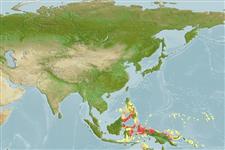Classification / Names
Common names | Synonyms | Catalog of Fishes (gen., sp.) | ITIS | CoL | WoRMS | Cloffa
Actinopterygii (ray-finned fishes) >
Perciformes (Perch-likes) >
Serranidae (Sea basses: groupers and fairy basslets) > Anthiinae
Etymology: Pseudanthias: Greek, pseudes = false + Greek, anthias = a fish, Sparus aurata (Ref. 45335); charleneae: Name given to honour the request of HSH Prince Albert II of Monaco.
Environment / Climate / Range
Ecology
Marine; benthopelagic; depth range 40 - 56 m (Ref. 74962). Deep-water, preferred ?
Western Pacific: Cenderawasih Bay, Indonesia.
Size / Weight / Age
Maturity: Lm ? range ? - ? cm
Max length : 7.5 cm SL male/unsexed; (Ref. 74962)
Dorsal
spines
(total): 10;
Dorsal
soft rays
(total): 16;
Anal
spines: 3;
Anal
soft rays: 7. This species is distinguished by the following characters: D X,16; A III,7; pectoral rays 17-18; lateral-line scales 47; gill rakers 11+ 25; moderately deep body, depth 2.4 in SL; papillae on posterior edge of orbit absent; fleshy protuberance at front of upper lip in males absent; vomerine teeth in a small triangular patch; third dorsal spine moderately elongate in males, 1.8 in HL; forked or lunate caudal fin, caudal concavity 1.4 in HL; in life, color of males mainly lavender pink with scattered orange flecks, grading to orange on head and anterodorsal part of body; a broad, tapering orange bar below middle of spinous dorsal fin, reaching to lower side; lavender-pink margined yellow band from snout tip to lower eye, continuing from lower rear corner of eye to pectoral-fin base; spinous dorsal fin lavender pink on basal half with broad yellow outer margin; soft dorsal fin mainly reddish orange, grading to yellow distally with narrow lavender-pink margin; anal fin mainly yellow with lavender pink anterior margin; caudal fin overall reddish orange with lavender submarginal band near tips of upper and lower lobes, the tips yellow-orange; pelvic fin yellow on anterior half and whitish posteriorly, with narrow lavender-pink anterior margin; pectoral fins translucent to slightly yellowish (Ref. 74962).
This species is rarely seen by divers due to its deep habitat. The holotype was collected on a steep rubble slope with abundant sea fans and was accompanied by about six smaller females (Ref. 74962). Forms aggregations (Ref 90102).
Life cycle and mating behavior
Maturity | Reproduction | Spawning | Eggs | Fecundity | Larvae
Allen, G.R. and M.V. Erdmann, 2008. Pseudanthias charleneae, a new basslet (Serranidae: Anthiinae) from Indonesia. Aqua Int. J. Ichthyol. 13(3-4):139-144. (Ref. 74962)
IUCN Red List Status (Ref. 115185)
CITES (Ref. 94142)
Not Evaluated
Threat to humans
Harmless
Human uses
More information
Common namesSynonymsMetabolismPredatorsEcotoxicologyReproductionMaturitySpawningFecundityEggsEgg development
ReferencesAquacultureAquaculture profileStrainsGeneticsAllele frequenciesHeritabilityDiseasesProcessingMass conversion
Tools
Special reports
Download XML
Internet sources
